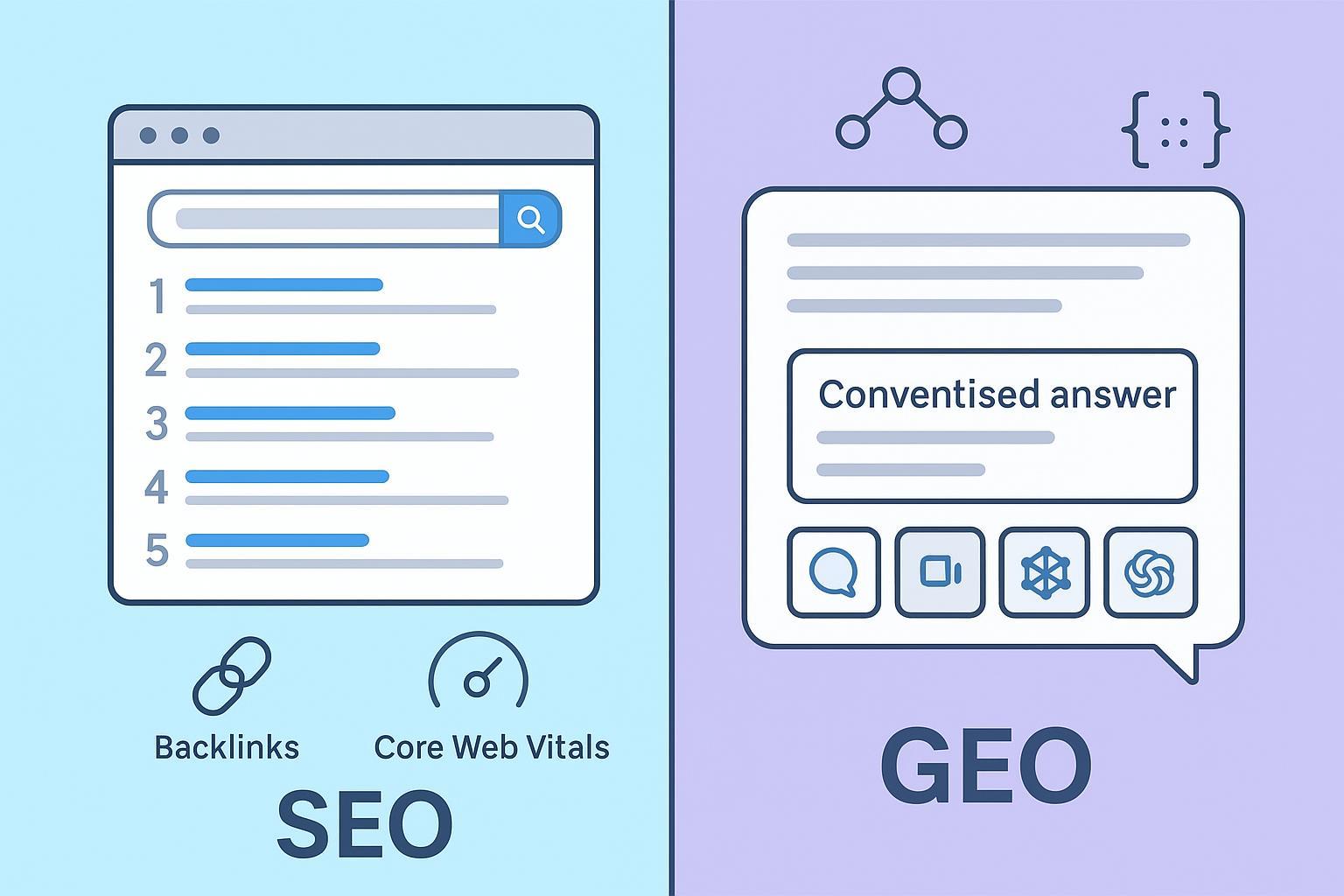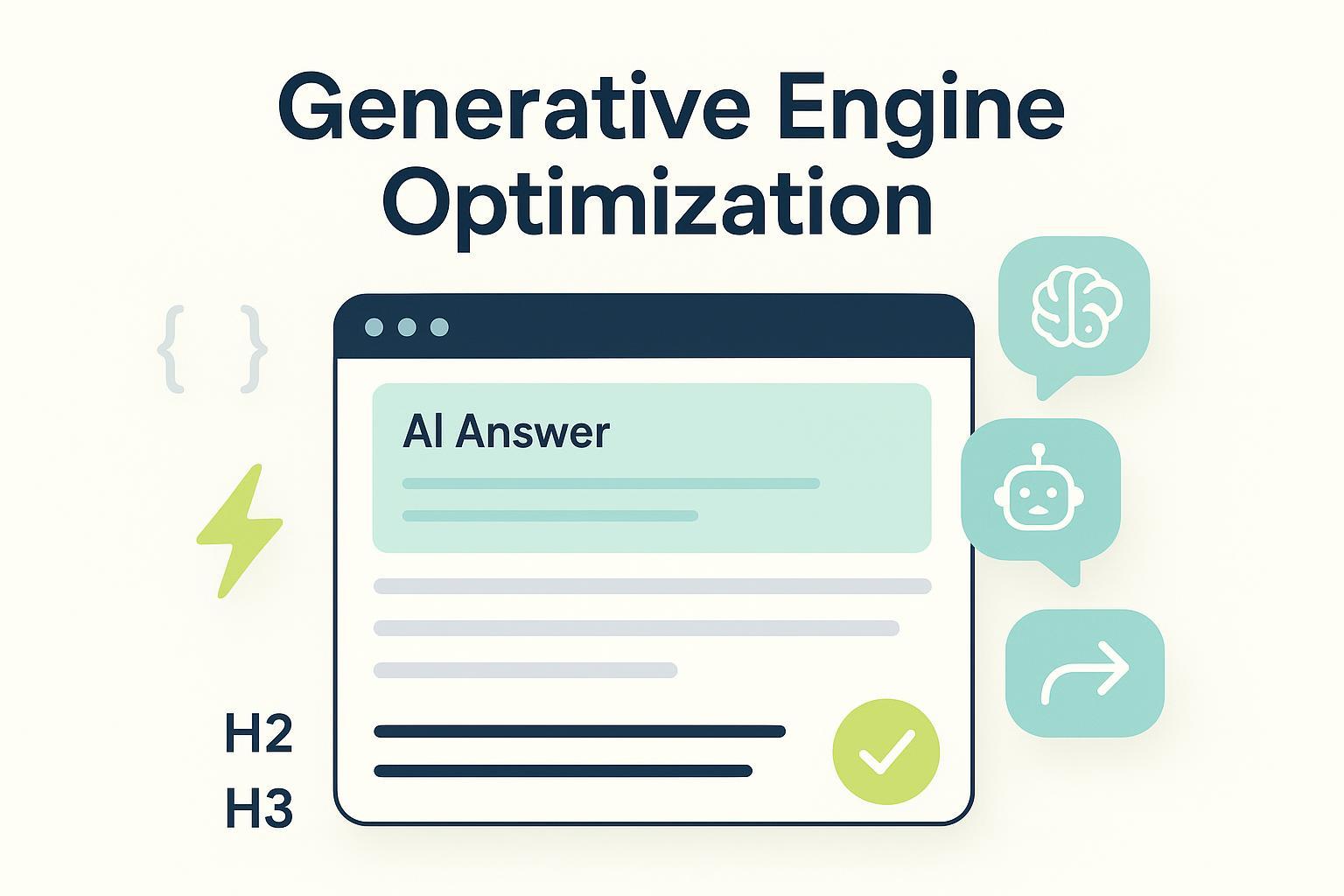SEO vs GEO (2025): Key Differences, Signals & Strategy
Discover the 2025 comparison of traditional SEO vs Generative Engine Optimization (GEO). Explore surface, signal, format, measurement, workflow, and risk differences for Google AI Overviews, Bing Copilot, Perplexity, and ChatGPT/Gemini.


If your team is planning 2025 budgets, one question keeps popping up: do we double down on classic SEO, or invest in Generative Engine Optimization (GEO) so our brand shows up inside AI answers? Think of SEO as optimizing for ranked links on a search results page, while GEO is about being selected, cited, and summarized inside engines like Google’s AI Overviews, Bing Copilot, Perplexity, and ChatGPT/Gemini. The surfaces, selection signals, and measurement models are different enough that your playbooks should be, too.
Target surfaces and selection signals
SEO aims to rank pages in Google/Bing SERPs. Signals include topical relevance, link equity, site quality, and user experience. GEO targets synthesized answers and conversational surfaces. Here, engines privilege entity clarity, factual consistency, corroboration across multiple sources, and citation-friendly provenance. Backlinks still help, but clarity and verifiability carry more weight in answer selection.
- According to Search Engine Land’s 2024 explainer, GEO focuses on being selected inside AI answers, with emphasis on clear entities, high-quality sources, and citeability (Search Engine Land, “What is Generative Engine Optimization (GEO)”, 2024-07-29).
- Practitioner analyses in 2025 (e.g., a16z’s overview) highlight entity disambiguation and multi-source corroboration as core signals for answer engines (a16z, “How Generative Engine Optimization Rewrites the Rules of Search”, 2025-05-28).
Content formats and technical stack
SEO favors comprehensive hub pages, internal linking, and schema to qualify for rich results. GEO favors modular, citeable chunks with explicit stats, named sources, and machine-readable endpoints.
- Structure content so engines can lift precise statements: short answer blocks, FAQs, tables with labeled units, and consistent author/date fields.
- Embed JSON-LD for key entities (Organization, Person, Article, FAQ, Dataset). Use stable identifiers (@id) and persistent URLs. Google’s guidance on structured data remains a cornerstone for machine readability (Google Search Central, “Introduction to structured data”, 2025-02-04).
- If you expose APIs (REST/GraphQL), include provenance (version, datePublished, license) and dereferenceable entity URLs so answer engines can verify facts.
- Understand crawler controls. Blocking Google-Extended alone won’t reliably prevent AI Overviews from using your content; it’s governed by Googlebot. Practitioners note that blocking Googlebot removes your traditional indexing and visibility—a real trade-off (Google Search Central, "Robots.txt" intro, 2025-02-04).
Measurement: what to track for SEO vs GEO
SEO measurement revolves around rankings, CTR, organic sessions, and conversions. GEO requires a different dashboard: citations inside AI answers, impressions of those answers, sentiment of how your brand is described, and share-of-voice across engines.
- Define “AI visibility” as how often your brand is referenced or linked in AI answers across engines and topics. For deeper definitions, see Geneo’s explainer on AI visibility and brand exposure in AI search.
- Track citation frequency by engine (AI Overviews, Copilot, Perplexity, ChatGPT browsing) and compare week-over-week trends. Media research in 2025 found citation accuracy varies by engine and domain, underscoring the need for verification workflows (CJR Tow Center, “We compared eight AI search engines—They’re all bad at citing news”, 2025-03-06).
- Attribute answer sentiment (positive/neutral/negative) and narrative framing. This matters for PR alignment and risk monitoring.
- Count referral clicks from answer panes where engines link back to sources.
SEO vs GEO: a quick comparison
| Dimension | Traditional SEO | GEO |
|---|---|---|
| Target surfaces | Ranked SERPs (Google/Bing) | AI-generated answers (AI Overviews, Copilot, Perplexity, ChatGPT/Gemini) |
| Selection signals | Backlinks, relevance, authority, Core Web Vitals | Entity clarity, corroboration across sources, provenance, E-E-A-T cues, explicit citeability |
| Content formats | Long-form hubs, internal linking, schema | Modular answer blocks, FAQs/tables, explicit statistics and sources, machine-readable endpoints |
| Technical stack | Titles/meta, XML sitemaps, schema.org, CWV | JSON-LD entities, APIs/JSON endpoints, version-stamped provenance, crawler controls |
| Measurement | Rankings, CTR, sessions, conversions | Citations, share-of-voice, impressions, sentiment, referral clicks, attribution accuracy |
| Workflows | Keyword research, link building, on-page/tech audits | Question/prompt graphs, source triangulation, entity consolidation, citation monitoring |
| Risks | Link spam penalties, thin content | Hallucinations, misattribution, outdated answers; provenance and expert review are essential |
Workflows and resourcing: different muscles
Your SEO team excels at keyword research, topic clustering, and technical health. Your GEO team needs to think in questions, sources, and entities.
- Map “prompt graphs”: list the core questions engines must answer about your category and products. Write short, precise answers backed by named sources.
- Triangulate sources: corroborate each claim across at least two authoritative references, preferably including primary/official documentation.
- Consolidate entities: make your brand, products, and experts unambiguous with consistent names, IDs, and structured data.
- Monitor citations and sentiment by engine; adjust content where attribution goes wrong or framing turns negative.
If you’re new to the concept, start with a primer: Generative Engine Optimization Beginner’s Guide.
Decision scenarios
Not every query deserves the same playbook. Here’s how teams typically prioritize.
- Ecommerce/transactional intent: SEO remains the primary revenue driver for product/category queries. Invest in technical performance, conversion content, and traditional rankings. Use GEO to support pre-search education—comparisons, how-tos, and trust signals that answer engines like to cite.
- Thought leadership/informational intent: GEO can dominate the answer surface. Build an authoritative library with well-cited explainers, tables, FAQs, and up-to-date references. Engines reward clarity and verifiability.
- Regulated/YMYL topics: Tighten governance. Apply expert review, version-stamp pages, avoid promotional CTAs, and expose provenance. When risk outweighs benefit, consider selective crawler blocking and strict disclosures. Practitioner and academic sources have documented hallucination and attribution risks; treat accuracy as a core requirement (IBM, “AI hallucinations”, 2023-09-26).
For platform behavior nuances across engines, see our neutral overview: ChatGPT vs Perplexity vs Gemini vs Bing: AI search monitoring comparison.
Risks and compliance: what can go wrong
Answer engines are powerful but imperfect.
- Hallucinations and misattribution: Even when engines show citations, they may summarize incorrectly or link to the wrong source. Build provenance into your content and verify common queries regularly. Media analysis in 2025 flagged accuracy gaps across engines (CJR Tow Center study, 2025-03-06).
- Outdated answers: Engines sometimes favor older pages or stale context. Use clear dates, author credentials, and version notes on pages and APIs.
- Crawler controls and trade-offs: There’s no granular “block AI Overviews only” switch. Blocking Googlebot removes SERP visibility; evaluate risk vs reward before making robots changes (Google Search Central robots intro, 2025-02-04).
If terminology feels dense, this short reference helps: GEO, GSVO, GSO, AIO, LLMO—acronyms explained.
Also consider: neutral tooling for measurement
Disclosure: Geneo is our product.
If you need a way to monitor AI citations, sentiment, and multi-engine visibility, compare options in this neutral overview: Geneo vs Profound vs Brandlight. Tools won’t replace strategy, but they make GEO measurement and troubleshooting far more practical.
How to choose a hybrid plan for 2025
Here’s the deal: keep SEO as your backbone for transactional queries and dependable traffic, and layer GEO for authoritative presence inside AI answers. Prioritize entity clarity, explicit citations, and provenance so engines can trust and reuse your content. Measure both worlds—rankings and conversions for SEO; citations, share-of-voice, impressions, sentiment, and attribution accuracy for GEO. Start with a few high-impact informational topics, validate how engines cite you, and expand where visibility and trust move the needle. The teams that combine solid SEO fundamentals with disciplined GEO workflows will own both links and answers in 2025.





